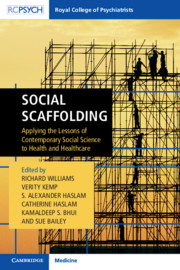Book contents
- Social Scaffolding
- Social Scaffolding
- Copyright page
- Contents
- Contributors
- Foreword
- Note
- Section 1 Schooling
- Chapter 1 Health and Society: Contributions to Improving Healthcare from the Social Sciences
- Chapter 2 Six Features of the Human Condition: The Social Causation and Social Construction of Mental Health
- Chapter 3 Social Sciences and Health: A Framework for Building and Strengthening Social Connectedness
- Chapter 4 The Social Identity Approach to Health
- Chapter 5 The Relevance of Social Science to Improving Health and Healthcare
- Section 2 Scoping
- Section 3 Sourcing
- Section 4 Scaffolding
- Section 5 Sustaining
- Index
- References
Chapter 1 - Health and Society: Contributions to Improving Healthcare from the Social Sciences
from Section 1 - Schooling
Published online by Cambridge University Press: 14 June 2019
- Social Scaffolding
- Social Scaffolding
- Copyright page
- Contents
- Contributors
- Foreword
- Note
- Section 1 Schooling
- Chapter 1 Health and Society: Contributions to Improving Healthcare from the Social Sciences
- Chapter 2 Six Features of the Human Condition: The Social Causation and Social Construction of Mental Health
- Chapter 3 Social Sciences and Health: A Framework for Building and Strengthening Social Connectedness
- Chapter 4 The Social Identity Approach to Health
- Chapter 5 The Relevance of Social Science to Improving Health and Healthcare
- Section 2 Scoping
- Section 3 Sourcing
- Section 4 Scaffolding
- Section 5 Sustaining
- Index
- References
Summary
This book’s roots are in an impactful seminar series hosted by the Royal College of Psychiatrists in which practitioners and scientists from a wide array of disciplines came together in 2014 to explore the social influences on our health and recovery from ill health. This volume echoes the evocative conversations in that College and is intended to rehearse research of potentially great impact. It presents practitioners, researchers, policymakers and students of a wide array of disciplines and roles with the material to support them in better harnessing what we now know about the impact of social factors on health. Thereby, the editors hope to influence how practitioners and the responsible authorities work together with members of the public and communities to design and deliver services. Our aspiration is to contribute to creating better-targeted approaches to promoting health and mental health and more effective and integrated interventions for people who have health problems or disorders.
- Type
- Chapter
- Information
- Social ScaffoldingApplying the Lessons of Contemporary Social Science to Health and Healthcare, pp. 1 - 9Publisher: Cambridge University PressPrint publication year: 2019



